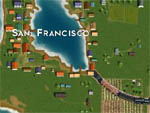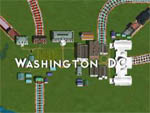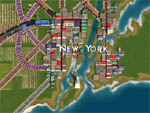Early Hours with…Rails across America (beta)So far, our Early Hours articles have consisted of hands-on time with newly released games. But there have been situations where we've spent enough time with pre-release builds of games to merit more extensive coverage than the usual 60 Second previews. Following are Tom's impressions of Rails across America after spending about a month futzing around with various betas of the full game. Assume all the standard disclaimers about this being a pre-release build; for all we know, the final version will lock up your computer, format your hard drive, and make fun of your haircut.
Tom's Comments: One of the most intriguing games I saw at this year's E3 was Flying Lab's Rails across America, a continuous-time rail empire game to be published by Strategy First later this summer. After playing some early builds, I think I've discovered another gem that can take its place in the array of this year's best strategy games coming from unlikely places: Europa Universalis, The Corporate Machine, Starships Unlimited, and now Rails across America. At first glance, you might write this off as a Railroad Tycoon II clone, but you'd be making a mistake. Although the most interesting screenshots of the game are the zoomed-in views that make it look up-close-and-personal like PopTop's homage to Sid Meier's classic, these images aren't a good representation of how it plays. Rails is more epic and abstract than Railroad Tycoon II. It's a game that plays from a much higher level and spans a broader swath of railroading. Whereas Railroad Tycoon II is the hands-on company manager's perspective, Rails gazes out from the wood-paneled office of the president. The playing field -- your board -- is a map of the North America and your basic task is to build railroads connecting cities. Every city has a certain amount of stuff that wants to get to other cities. For instance, New York has passengers and cargo for Albany, Philadelphia, Hartford, and Salt Lake City. If you connect any of these cities, you earn income for each carload your line can carry. You can pay to improve your lines and trains so they can accommodate more traffic. But then there's competition, which is just as important in Rails across America as actually building your network. When two companies run routes between a city and its desired destination, they split the fee based on the proportion of the traffic they carry. Traffic will gravitate towards the faster line, so you can steal business from your opponent by running a more efficient route. There are times when you'll be cooperating with your competitors. Let's take the example of the passenger and cargo that want to go from New York to Salt Lake City. No single line can run that far, so the cargo will move along contiguous segments. If one third of the route in owned by me, another third is owned by Vanderbilt, and the final third is owned by Gould, our companies split the money three ways. There's a sort of diplomatic interaction where you can shut down cooperation, depriving you and a specific competitor of shared fees. |
|||


